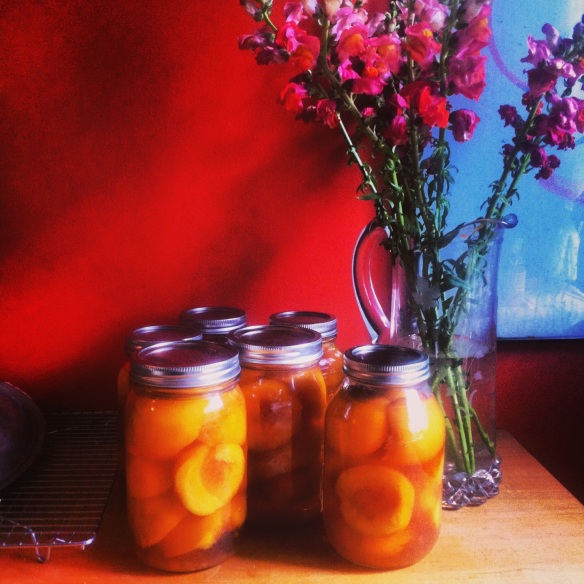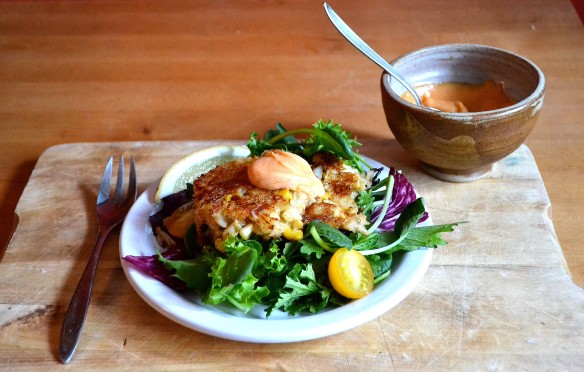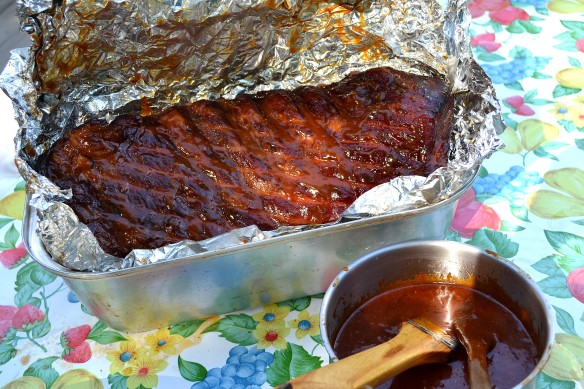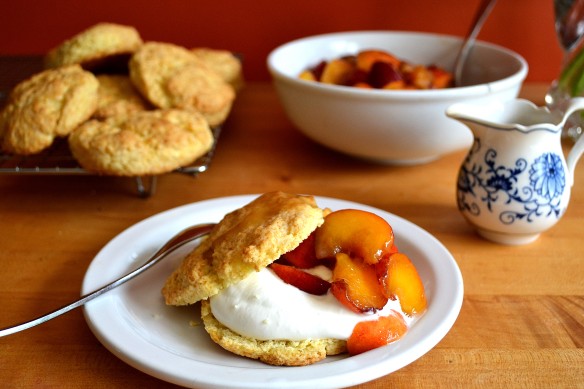 Many people shy away from cooking octopus, believing that it is too difficult to cook. The truth is slightly different. Octopus is relatively easy to cook; it’s tenderizing the octopus that poses the challenges. Perfectly-cooked octopus definitely must not be rubbery, but one also must not commit the cardinal sin of mushy octopus. Everyone seems to have a different method for tenderizing octopus. Some people literally beat octopus with a rock, or, failing that, with a meat tenderizer. My friend Patrick sets up a pot of boiling water and a pot of ice water, and plunges the octopus in each water bath for about ten seconds, switching back and forth, about 30 times. I have heard that tenderizing the octopus sous vide works extremely well. I used to simmer octopus for about an hour in a pot of water to which some milk (the lactic acid works the trick) has been added. But I swear by my new method, which is time-consuming, but infallibly produces excellent results. Continue reading
Many people shy away from cooking octopus, believing that it is too difficult to cook. The truth is slightly different. Octopus is relatively easy to cook; it’s tenderizing the octopus that poses the challenges. Perfectly-cooked octopus definitely must not be rubbery, but one also must not commit the cardinal sin of mushy octopus. Everyone seems to have a different method for tenderizing octopus. Some people literally beat octopus with a rock, or, failing that, with a meat tenderizer. My friend Patrick sets up a pot of boiling water and a pot of ice water, and plunges the octopus in each water bath for about ten seconds, switching back and forth, about 30 times. I have heard that tenderizing the octopus sous vide works extremely well. I used to simmer octopus for about an hour in a pot of water to which some milk (the lactic acid works the trick) has been added. But I swear by my new method, which is time-consuming, but infallibly produces excellent results. Continue reading
Linguine with Sea Urchin Roe (Uni) Sauce
 Strictly speaking, the edible part of sea urchin – uni, as it’s called in Japanese – isn’t roe at all. It is the animal’s gonads, and will eventually turn into sperm (milt) or roe, depending on the animal’s sex. Uni is a delicacy, and an acquired taste. It is intensely briny, with a heady, floral, loamy aftertaste. In Japan, it’s served most commonly as nigiri sushi, on rice, and it is classified according to quality, based upon its color, flavor, and firmness. Uni is best eaten fresh, i.e., from an animal that you have just killed yourself, however you can also buy uni cleaned, packaged, and ready to eat. This dish – al dente linguine, served in a rich sauce made with fresh raw uni emulsified with melted butter and lemon – is a coastal Italian classic, and, cleaning of the sea urchin aside, it is quick and remarkably easy to prepare. It tastes like nothing you have ever eaten before in your life. Continue reading
Strictly speaking, the edible part of sea urchin – uni, as it’s called in Japanese – isn’t roe at all. It is the animal’s gonads, and will eventually turn into sperm (milt) or roe, depending on the animal’s sex. Uni is a delicacy, and an acquired taste. It is intensely briny, with a heady, floral, loamy aftertaste. In Japan, it’s served most commonly as nigiri sushi, on rice, and it is classified according to quality, based upon its color, flavor, and firmness. Uni is best eaten fresh, i.e., from an animal that you have just killed yourself, however you can also buy uni cleaned, packaged, and ready to eat. This dish – al dente linguine, served in a rich sauce made with fresh raw uni emulsified with melted butter and lemon – is a coastal Italian classic, and, cleaning of the sea urchin aside, it is quick and remarkably easy to prepare. It tastes like nothing you have ever eaten before in your life. Continue reading
Huckleberry-Fig Chutney
 My favorite fact about chutney: the word derives from the Sanskrit word caṭnī, meaning to lick. Chutneys are, loosely, a mixture of vegetables or fruit (or both) and spices. Indian chutneys can be cooked or raw, blended or pounded, pickled or fresh. In the West, chutneys are usually a combination of fruit, savory spices, sugar, and vinegar.
My favorite fact about chutney: the word derives from the Sanskrit word caṭnī, meaning to lick. Chutneys are, loosely, a mixture of vegetables or fruit (or both) and spices. Indian chutneys can be cooked or raw, blended or pounded, pickled or fresh. In the West, chutneys are usually a combination of fruit, savory spices, sugar, and vinegar.
My palate for Western chutneys developed late. For a long time, I thought they were yucky. Salty spicy vinegary fruity pickle? Blech. Perhaps my aversion was a consequence of having to politely eat haroseth (a mixture of apples, wine, chopped nuts, and spices traditionally served at Passover seders) at an early age. But. Eat enough tagines in which apricots and quince have been slowly simmered with meats, salty cheese and French fig jam, cantaloupe and prosciutto, and eventually one starts to enjoy, albeit reluctantly, the contrasting tastes of sugar and salt, fruit and vinegar and spice in Western chutneys. Another fun fact: Western cuisines tend to pair ingredients that share flavour compounds, whereas many Asian, and particularly East Asian, cuisines tend to pair contrasting ingredients. Continue reading
Peach Upside-Down Cake
 The last of the peaches. Parental scoffing notwithstanding, I found using up 25 pounds of peaches a formidable task. Despite making six quarts of canned peaches, four jars of peach jam, peach salsa, grilled peaches, and freezing a sack of peeled, sliced peaches for future use (a cop-out, I know), last week several bruised, wrinkly peaches, the remnants from my haul, still regarded me forlornly from the dry sink. Continue reading
The last of the peaches. Parental scoffing notwithstanding, I found using up 25 pounds of peaches a formidable task. Despite making six quarts of canned peaches, four jars of peach jam, peach salsa, grilled peaches, and freezing a sack of peeled, sliced peaches for future use (a cop-out, I know), last week several bruised, wrinkly peaches, the remnants from my haul, still regarded me forlornly from the dry sink. Continue reading
My Mother’s Canned Peaches
 High on the list of the many things my mother does very, very well in the kitchen is pickling and preserving. During the summertime, my telephone conversations with my parents usually go something like this:
High on the list of the many things my mother does very, very well in the kitchen is pickling and preserving. During the summertime, my telephone conversations with my parents usually go something like this:
Me: What have you been doing?
Mom/Dad, triumphantly: We now have 27 quarts of blueberries from our own bushes!
Or,
We bought a bushel of tomatoes at the farmstand!
Or sometimes,
We picked three huge baskets of chanterelles!
And then later,
Your mother made the most incredible [insert] [jam/pickles/sauce/pie/vegetable tart/canned peaches/pears/plums]! Continue reading
Nectarine Shortcakes with Nectarine Butter Caramel
The end of summer is bittersweet. In the Pacific Northwest at midsummer it gets dark at 10 p.m., but by the end of August the days get shorter, the nights cooler, and the rain begins to return. This summer in Seattle has been glorious, and Labor Day weekend has given us a last burst of sunshine. Next week, however, it is going to rain. And rain. Hello autumn. Fortunately the markets are still full of splendid peaches, nectarines, and beautiful Italian plums, the last taste of summer.
I was in the Yakima Valley, in Eastern Washington, this weekend for a wedding. Yakima Valley is peach country. (It is also wine country, but that is a story for another day.) In Union Gap, a tiny town whose largest employer is a fruit packing company, I lost my mind and bought 25 pounds of canning peaches. At home, I spread them out to ripen and thought, “I had better do something about those nectarines.” Continue reading
Dungeness Crab and Corn Cakes with Sriracha Mayonnaise
 This week I have been grappling with the Great Crustacean Controversy. Specifically, do the crabs, lobsters, and other crustaceans we eat feel pain, and if so, what is the most humane way to kill them? Or, as David Foster Wallace famously phrased it (far more articulately and precisely than I ever could), “Is it all right to boil a sentient creature alive just for our gustatory pleasure?” At a more ignorant time of my life, I blithely tossed live lobsters into pots of boiling water, clapped the lid on, and equally blithely devoured them. Lobsters don’t scream when you cook them – that much is myth – but recent studies suggest that crustaceans do in fact feel pain, or at least they exhibit behaviors consistent with the avoidance of remembered pain, strongly supporting an inference that they experience pain. It thus is most humane to kill them before cooking them. But how? Maybe some of you remember the lobster scene from Mostly Martha, the 2001 film about a German chef who discovers her softer side thanks to her niece and an Italian sous chef. She sobs over the abstract suffering of the lobster, which in most circumstances is denied the mercy of a swift death. Even Gordon Ramsay kills his lobsters before cooking them. Continue reading
This week I have been grappling with the Great Crustacean Controversy. Specifically, do the crabs, lobsters, and other crustaceans we eat feel pain, and if so, what is the most humane way to kill them? Or, as David Foster Wallace famously phrased it (far more articulately and precisely than I ever could), “Is it all right to boil a sentient creature alive just for our gustatory pleasure?” At a more ignorant time of my life, I blithely tossed live lobsters into pots of boiling water, clapped the lid on, and equally blithely devoured them. Lobsters don’t scream when you cook them – that much is myth – but recent studies suggest that crustaceans do in fact feel pain, or at least they exhibit behaviors consistent with the avoidance of remembered pain, strongly supporting an inference that they experience pain. It thus is most humane to kill them before cooking them. But how? Maybe some of you remember the lobster scene from Mostly Martha, the 2001 film about a German chef who discovers her softer side thanks to her niece and an Italian sous chef. She sobs over the abstract suffering of the lobster, which in most circumstances is denied the mercy of a swift death. Even Gordon Ramsay kills his lobsters before cooking them. Continue reading
75th Birthday Barbecued Ribs
 It’s good to have people in your life who push you out of your comfort zone. My lovely friend Nicola pushes me way past my comfortable depth (in positive ways), and leads by example. Thanks to Nicola, in early May, I found myself in a car with four people driving to a smallish unpretty town about an hour south of London, where, along with three other friends, we would cook overnight in the British Barbecue Society’s Grassroots Shake and Sauce competition. Continue reading
It’s good to have people in your life who push you out of your comfort zone. My lovely friend Nicola pushes me way past my comfortable depth (in positive ways), and leads by example. Thanks to Nicola, in early May, I found myself in a car with four people driving to a smallish unpretty town about an hour south of London, where, along with three other friends, we would cook overnight in the British Barbecue Society’s Grassroots Shake and Sauce competition. Continue reading
Miso Ginger Glaze
 My mother is one of the world’s great food hoarders. Her freezer is always packed so full that when you open the freezer door things invariably tumble out: half a dozen New York bagels in a plastic bag, a Tupperware container of chicken stock, frozen leftovers, frozen packages of butter. The refrigerator is the same. Growing up, I did not realize that this was anything but normal. I’d look in friends’ refrigerators and think, “Where is the FOOD?” It should go without saying that this condition, if not hereditary, at least must create a strong genetic predisposition. I am always ready for the apocalypse; I reckon that I could feed myself and a small band of hardy survivors for at least a few months, although I do wonder what I’d do when I run out of cat food. Continue reading
My mother is one of the world’s great food hoarders. Her freezer is always packed so full that when you open the freezer door things invariably tumble out: half a dozen New York bagels in a plastic bag, a Tupperware container of chicken stock, frozen leftovers, frozen packages of butter. The refrigerator is the same. Growing up, I did not realize that this was anything but normal. I’d look in friends’ refrigerators and think, “Where is the FOOD?” It should go without saying that this condition, if not hereditary, at least must create a strong genetic predisposition. I am always ready for the apocalypse; I reckon that I could feed myself and a small band of hardy survivors for at least a few months, although I do wonder what I’d do when I run out of cat food. Continue reading
Raspberry Salted Pine Nut Brittle Ice Cream
 So I had another post in the line-up to publish today, but with the east coast, England, and northern Europe choking in a heat wave, I felt that I should bump something cool, refreshing, and summery to the head of the queue. And what a summer treat it is! I am IMMENSELY PROUD of this ice cream. I made it last weekend, in my nearly new ice cream maker, after I had another no-self-control U-Pick experience. After a little more than an hour, I’d picked six pounds of raspberries and four pounds of blueberries, and it’s only thanks to my sister, who was with me and able to lead me from temptation, that I did not pick more. Having far too many raspberries is not exactly a crisis. I used over half a pound of them for this recipe, and more than anything, it made me wonder why raspberry ice creams are not more common, because raspberry ice cream is DELICIOUS. Continue reading
So I had another post in the line-up to publish today, but with the east coast, England, and northern Europe choking in a heat wave, I felt that I should bump something cool, refreshing, and summery to the head of the queue. And what a summer treat it is! I am IMMENSELY PROUD of this ice cream. I made it last weekend, in my nearly new ice cream maker, after I had another no-self-control U-Pick experience. After a little more than an hour, I’d picked six pounds of raspberries and four pounds of blueberries, and it’s only thanks to my sister, who was with me and able to lead me from temptation, that I did not pick more. Having far too many raspberries is not exactly a crisis. I used over half a pound of them for this recipe, and more than anything, it made me wonder why raspberry ice creams are not more common, because raspberry ice cream is DELICIOUS. Continue reading

